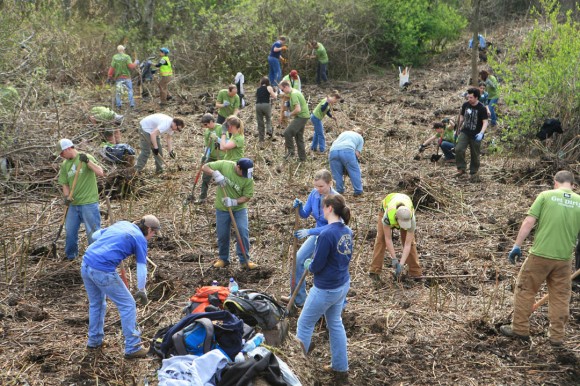
West Hylebos Wetlands: A Place Worth Preserving
by: EarthCorps Friends of the Hylebos: Steve Dubiel and Blair Edwards Posted on: September 28, 2011
By Steve Dubiel (EarthCorps Executive Director) and Blair Edwards (EarthCorps Intern)
All too often, we look to wilderness to find nature and overlook nature when it’s in our backyard. Twenty-three miles south of Seattle is the city of Federal Way. To the average person this means strip malls and urban sprawl, but to Illene and Francis Marckx this area is the home to a cause worth devoting their energy to conserve for future generations.
Illene and Francis Marckx purchased their plot of land in Federal Way when it was, due to its location off of Highway 99, just emerging as a commercial center in the 1970’s. Illene was a science teacher and Francis was in the poultry business. Their lives were forever changed when they crossed through the thick shrubbery in the back of their property. This brush gave way to a spectacular feat of nature that was worth fighting for: the West Hylebos Wetlands. They quickly realized this wetland was home to a bog containing a wide array of native species. The Marckxes became active in protecting the wetlands immediately following their discovery. In 1975 they successfully dissuaded the sewer district from running truck lines over the length of the wetlands. Six years later the Marckxes donated 23.5 acres of their property to Washington State Parks, to ensure that the wetlands would be protected for future generations. Now in public ownership, the wetlands are protected from future development.
West Hylebos Wetland, which originates from the land donated by the Marckxes, is home to an incredible diversity of native flora and fauna. Biologists have catalogued 27 species of moss, 37 lichens, 30 fungi, six ferns, six liverworts, 15 tree species and dozens of shrubs and herbs, including all three of the regions rare wild roses and other rare and locally rare species. Additionally, peat bogs like the West Hylebos Wetland sequester carbon more densely than rain forests, providing a critical carbon sink as we tackle climate change.
Bogs also perform pollutant-cleansing, water-absorbing and flood-regulation functions. West Hylebos Wetlands, and the entire Hylebos Watershed, serves as a massive natural water drainage and purifying system that functions better than anything manmade. This utility minimizes polluted stormwater runoff, which is one of the greatest threats to Puget Sound health.
Despite the exceptional ecological value of this wetland as well as its quality of life benefits, there are still many obstacles that threaten its health. The simple fact is, pollution from stormwater runoff, population growth, and both commercial and residential development will continue to impact our region’s remaining natural areas. It is imperative to conserve remaining natural lands, to restore their natural function, and to engage surrounding communities in long-term stewardship. It is our obligation to leave the earth to future generations in a better state than we found it.
West Hylebos Wetlands is preserved for future generations thanks to Illene and Francis Marckx as well as hundreds of volunteers dedicated to healing the wetlands. The Friends of the Hylebos has been working with the community to protect and restore streams, wetlands, forests and open space in the Hylebos watershed since 1983. Their work includes placing land into conservation through conservation easements and by soliciting public and private money to place land into public ownership, engaging volunteers, removing invasive plants, planting native trees and shrubs, rebuilding a boardwalk to provide public access, and placing large logs in Hylebos Creek to improve habitat. In 2011, Friends of the Hylebos joined forces with EarthCorps, a leading environmental restoration and community-building organization, and a long-time partner. EarthCorps has been working alongside The Friends of the Hylebos for more than a decade. EarthCorps/Friends of the Hylebos combines a passion for conservation, restoration, and collaboration as well as a knack for getting things done to make this watershed a healthier place for people and for wildlife.
Together, EarthCorps/Friends of the Hylebos will continue to conserve and restore not only West Hylebos Wetlands, but also the entire Hylebos Watershed. Restoring wetlands and salmon streams involves invasive plant removal, native plantings, and placement of engineered woody debris structures that enhance the salmon habitat and the structural diversity of the stream. Restoration takes place through public-private partnerships and through volunteerism. To get involved, visit www.earthcorps.org and www.hylebos.org. This restoration allows the wetlands to thrive as it had for the many centuries prior to the settlement of the Northwest.
Articles On Flora
Flora: Flora
- Apr 1 Big or Small: Who Will Grow Washington’s Cannabis Crop?
- Jul 19 A Case to Protect Public Land
- Apr 6 Oregon is a Desert State
- Dec 14 Forest Protection-The Olympic Peninsula
- Nov 30 Keeping Working Forests on the Landscape
- Nov 2 It’s a Wild Life – Can You Spare Some Passion?
- Sep 28 West Hylebos Wetlands: A Place Worth Preserving
- Aug 8 12,000 Rain Gardens
- Jul 11 Investing in Seed Banks
- Oct 21 Native Plant Spotlight: Oregon Grape
- Oct 21 Washington’s Roadless Forests

